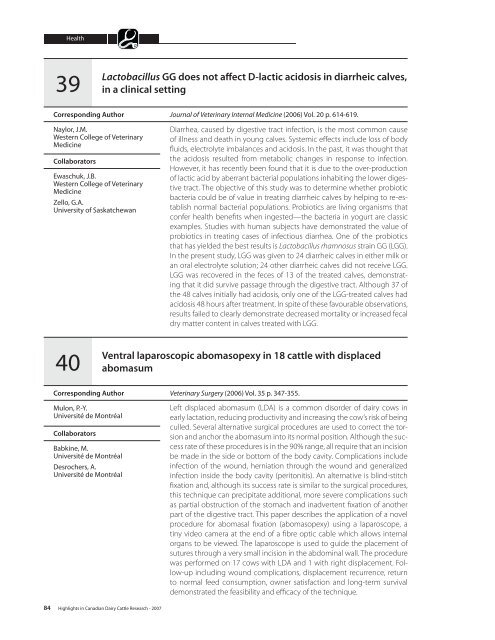A52-75-2007E.pdf - AgroMedia International Inc
A52-75-2007E.pdf - AgroMedia International Inc
A52-75-2007E.pdf - AgroMedia International Inc
Create successful ePaper yourself
Turn your PDF publications into a flip-book with our unique Google optimized e-Paper software.
Health39Lactobacillus GG does not affect D-lactic acidosis in diarrheic calves,in a clinical settingCorresponding AuthorNaylor, J.M.Western College of VeterinaryMedicineCollaboratorsEwaschuk, J.B.Western College of VeterinaryMedicineZello, G.A.University of SaskatchewanJournal of Veterinary Internal Medicine (2006) Vol. 20 p. 614-619.Diarrhea, caused by digestive tract infection, is the most common causeof illness and death in young calves. Systemic effects include loss of bodyfluids, electrolyte imbalances and acidosis. In the past, it was thought thatthe acidosis resulted from metabolic changes in response to infection.However, it has recently been found that it is due to the over-productionof lactic acid by aberrant bacterial populations inhabiting the lower digestivetract. The objective of this study was to determine whether probioticbacteria could be of value in treating diarrheic calves by helping to re-establishnormal bacterial populations. Probiotics are living organisms thatconfer health benefits when ingested—the bacteria in yogurt are classicexamples. Studies with human subjects have demonstrated the value ofprobiotics in treating cases of infectious diarrhea. One of the probioticsthat has yielded the best results is Lactobacillus rhamnosus strain GG (LGG).In the present study, LGG was given to 24 diarrheic calves in either milk oran oral electrolyte solution; 24 other diarrheic calves did not receive LGG.LGG was recovered in the feces of 13 of the treated calves, demonstratingthat it did survive passage through the digestive tract. Although 37 ofthe 48 calves initially had acidosis, only one of the LGG-treated calves hadacidosis 48 hours after treatment. In spite of these favourable observations,results failed to clearly demonstrate decreased mortality or increased fecaldry matter content in calves treated with LGG.40Ventral laparoscopic abomasopexy in 18 cattle with displacedabomasumCorresponding AuthorMulon, P.-Y.Université de MontréalCollaboratorsBabkine, M.Université de MontréalDesrochers, A.Université de MontréalVeterinary Surgery (2006) Vol. 35 p. 347-355.Left displaced abomasum (LDA) is a common disorder of dairy cows inearly lactation, reducing productivity and increasing the cow’s risk of beingculled. Several alternative surgical procedures are used to correct the torsionand anchor the abomasum into its normal position. Although the successrate of these procedures is in the 90% range, all require that an incisionbe made in the side or bottom of the body cavity. Complications includeinfection of the wound, herniation through the wound and generalizedinfection inside the body cavity (peritonitis). An alternative is blind-stitchfixation and, although its success rate is similar to the surgical procedures,this technique can precipitate additional, more severe complications suchas partial obstruction of the stomach and inadvertent fixation of anotherpart of the digestive tract. This paper describes the application of a novelprocedure for abomasal fixation (abomasopexy) using a laparoscope, atiny video camera at the end of a fibre optic cable which allows internalorgans to be viewed. The laparoscope is used to guide the placement ofsutures through a very small incision in the abdominal wall. The procedurewas performed on 17 cows with LDA and 1 with right displacement. Follow-upincluding wound complications, displacement recurrence, returnto normal feed consumption, owner satisfaction and long-term survivaldemonstrated the feasibility and efficacy of the technique.84 Highlights in Canadian Dairy Cattle Research - 2007





